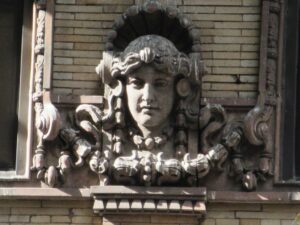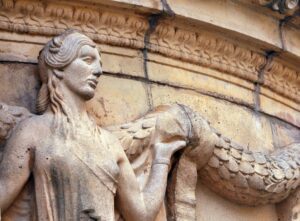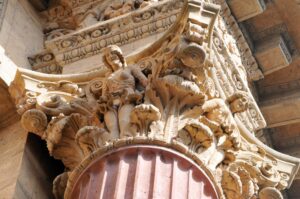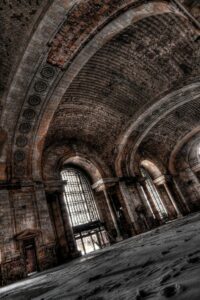Beaux-Arts architecture is a lavish celebration of symmetry, classical detail, and grandeur, instantly recognizable by its opulent design.
Originating from the École des Beaux-Arts in Paris, this style has left a lasting impression on the skylines of cities across the United States.
In our exploration, we’ll unveil the defining features of Beaux-Arts architecture, from its grand stairways to its elaborate sculptures, and understand why it became the blueprint for America’s most iconic buildings.
Stay with us as we jump into the history and characteristics of this extravagant architectural style that continues to captivate architects and onlookers alike.
History Of Beaux-Arts Architecture
Beaux-Arts architecture traces its roots to the mid-19th century when the style dominated French cultural institutions and grand residences.
The École des Beaux-Arts in Paris was the epicenter of this movement, crafting architects with a penchant for both classical principles and Renaissance flourishes.
Our appreciation for the lavishly ornamental and harmonious proportions of this style stems from its timeless appeal.
As we jump into the international transplantation of Beaux-Arts, we see the style’s prominence at the 1893 World’s Columbian Exposition in Chicago.
This event, which spotlighted Beaux-Arts on a grand scale, demonstrated its potential to symbolize progress and civilization.
The showcase included pivotal works and served as an inspiration, encouraging the style’s adoption in North America where it shaped the skylines of burgeoning cities.
Key influences on the development and spread of Beaux-Arts included:
- Academic training at the École des Beaux-Arts.
- International expositions, like the one held in Chicago.
- The city-beautiful movement, which aimed to introduce beautification and monumental grandeur into American urban planning.
In our exploration, we can’t ignore the dynamic evolution of architecture as it adapts to cultural shifts.
Beaux-Arts architecture found its way into the fabric of American society just as it was striding towards modernity.
Buildings like New York Public Library and Grand Central Terminal were born from this tradition, enveloping the technological advancements of the age with a classical aesthetic.
Our recognition of these icons today reflects their enduring legacy and the magnetic allure of Beaux-Arts architecture.

The Influence Of The École Des Beaux-Arts
The École des Beaux-Arts looms large in the shaping of Beaux-Arts architecture.
As the epicenter of art education in 19th-century France, the institution fostered a rigorous environment where students absorbed classical principles.
These foundational teachings infused their work with a sense of grandeur and academic rigor, vital ingredients in the Beaux-Arts recipe.
Our exploration of this prestigious school uncovers a curriculum steeped in histoire—the French word for both history and story.
Students there embarked on an intensive study of past architectural giants like Vitruvius and Michelangelo.
They worked on meticulous drawings and plans, honing their skills in creating structures that were as much a nod to history as they were a step forward in design.
Moving beyond the classroom, the influence of the École des Beaux-Arts alumni is undeniable.
Many left an indelible mark on the architectural canvas of the 19th and early 20th centuries, with notable names including:
- Charles Garnier, the visionary behind the opulent Palais Garnier,
- Richard Morris Hunt, who introduced the style with great flourish to the United States,
- Ange-Jacques Gabriel, celebrated for the exquisite Place de la Concorde.
To this day, we see the techniques and principles learned at the École des Beaux-Arts echoed in the architectural elegance of buildings worldwide.
In the historical layers of these structures, the echoes of the school’s influence resonate, demonstrating its inextricable link to the grand narrative of Beaux-Arts architecture.
Key Characteristics Of Beaux-Arts Architecture
As experts in art history, we’ve observed that Beaux-Arts architecture incorporates a variety of features that are deeply rooted in classical aesthetics.
Synthesizing modern and classical elements, Beaux-Arts buildings are often grandiose in scale, projecting a sense of magnificence and opulence.
This architectural style can be recognized by several key characteristics:
- Symmetry and Order: One of the hallmarks of Beaux-Arts architecture is its symmetrical design. Facades are meticulously planned to create harmonious and balanced visuals.
- Rich Decorative Detailing: Elaborate decorations are a signature of Beaux-Arts design. These often include sculptures, friezes, and carvings that echo Greco-Roman iconography.
Another distinct aspect of Beaux-Arts architecture is the emphasis on grand entrances.
These are typically characterized by:
- Stately stairs,
- Impressive archways.
Such features not only enhance the aesthetic appeal but also serve to emphasize the importance of the structure.
These entrances often lead to equally elaborate interiors, with a strong focus on luxury and detail.
Beaux-Arts architecture makes extensive use of classical columns and pilasters, drawing inspiration from Greek and Roman temples.
These elements support the weight of the structure and add to the stately appearance.
Scrupulously crafted, the columns are not merely functional but also serve an ornamental purpose, demonstrating the style’s commitment to beauty and strength.
also, Beaux-Arts buildings commonly feature a flat or low-pitched roof.
This allows for the facade to dominate the visual field, directing attention to the rich decorative details that line the building’s exterior.
The roof often includes a balustrade or may be adorned with statuary, further enhancing the grandeur and elevated status of the architecture.
Symmetry And Classical Detail In Beaux-Arts Buildings
When we examine Beaux-Arts architecture, symmetry isn’t just a feature; it’s a fundamental principle that anchors the entire design philosophy.
The balance achieved through symmetrical planning instills a sense of harmony and order, often seen as essential qualities in this architectural style.
Our discerning gaze recognizes that the central axis is not just a design choice but a bold statement of stability and permanence.
Diving into the opulent ornamentation, we’re met with a celebration of detail that is quintessentially Beaux-Arts.
It’s where classical influences are not just referenced, they’re revered.
Pilasters, columns, and statuary are not mere decorative elements; they pay homage to an illustrious past, echoing the grandeur of ancient Rome and Greece.
The façades are canvases showcasing the splendor of the Arts:
- Robust columns evoke the strength of the ancient world,
- Pilasters frame windows and entrances, enhancing their importance,
- Sculptures and friezes depict scenes of cultural significance, adding a narrative layer to the visual experience.
Intricacies are woven into the very fabric of Beaux-Arts buildings, leaving a signature of sophistication and luxury.
The rich decorative detail is not only a testament to the skill of craftsmen and artisans but also to the ambition of an era that sought to immortalize its values in stone, metal, and glass.
Whether it’s the grand entrance or the meticulous stone carvings, every feature of a Beaux-Arts building is curated to impress and express a legacy of artistic excellence.
Grand Stairways And Elaborate Sculptures In Beaux-Arts Architecture
Grand stairways are a hallmark of Beaux-Arts architecture, acting as a dramatic focal point in these magnificent buildings.
These staircases are not just functional; they command attention, urging visitors to ascend with a sense of awe.
Balustrades crafted with precision, often adorned with intricate ironwork or stonemasonry, enhance the grandeur of these architectural features.
The presence of elaborate sculptures in Beaux-Arts architecture is undeniable.
These sculptures are usually:
- Sited prominently above entrances or at the crest of gables,
- Crafted with a high degree of skill, often telling a story or representing allegorical figures,
- Integral to the narrative that the building itself seeks to convey.
In Beaux-Arts design, sculptures are more than mere decoration.
They serve to commemorate historical events, honor cultural icons, or exemplify the values of the institution housed within.
Take, for instance, the grand edifices of the New York Public Library or the San Francisco Opera House, where sculptures bring to life the ethos of enlightenment and artistic excellence.
These sculptural elements, paired with grand stairways, create a flowing transition from the exterior grandiosity to the splendor within.
They set the stage, so to speak, for the opulent interiors that await visitors and patrons, much like a grand entrance in a classic film establishes the tone of the cinematic experience to come.
In our work at filmmaking lifestyle, we appreciate how architecture can provide not just a backdrop, but a narrative element as powerful as any storyline or character arc.
Beaux-Arts Architecture In The United States
Once it crossed the Atlantic, Beaux-Arts architecture infused American cities with a sense of grandeur that mirrored the prosperity of the Gilded Age.
In the United States, the style was not just about opulence but also symbolized the country’s ambitions on the world stage.
New York City’s iconic structures like the New York Public Library and Grand Central Terminal bear the hallmarks of this style’s influence.
The proliferation of Beaux-Arts in the US can be credited to American architects who studied at the École des Beaux-Arts.
These architects returned with a penchant for Beaux-Arts principles, adapting them to American sensibilities and the burgeoning urban landscapes.
Chicago’s Columbian Exposition in 1893 was a defining moment that showcased the grandiosity of Beaux-Arts to the wider public.
Among the roster of noteworthy buildings, a few stand out for their exemplary Beaux-Arts design:
- The Metropolitan Museum of Art in New York City extends an invitation to the world of fine arts with its ceremonial grandeur.
- San Francisco’s City Hall, with its domed façade, reflects the principles of Beaux-Arts through balance and symmetry.
- The Boston Public Library serves as a testament to the intellectual legacy cocooned in grand architectural splendor.
With its roots in the artistic movements of France, Beaux-Arts architecture in the US encompasses more than just buildings; it’s a celebration of craftsmanship, history, and the pursuit of grandeur.
Our streets and skylines are richer for its presence.
It adorns American cities with a veneer of classical elegance, a reminder of a bygone era interpreted through the modern aspirations of a nation coming into its own on the global stage.
Examples Of Iconic Beaux-Arts Buildings
As experts in art movements, we’ve been fascinated by the exemplary structures of the Beaux-Arts era.
Across the globe, these buildings serve not just as cultural landmarks but also as testament to an architectural philosophy steeped in grand beauty and precision.
Let’s explore some of the most iconic Beaux-Arts buildings that continue to captivate us with their timeless appeal.
In the heart of New York City lies the New York Public Library, a quintessential example of Beaux-Arts architecture.
The library dazzles with its monumental façade and the intricate sculptures by Paul Wayland Bartlett.
Inside, the Astor Hall welcomes visitors with vaulted ceilings and marble arches, embodying the essence of this opulent style.
San Francisco’s City Hall stands as a symbol of resilience and rebirth following the 1906 earthquake.
This masterpiece showcases the Beaux-Arts signature features:
- Grandiose rotundas,
- Sweeping staircases,
- Classical columns.
With the completion of the Opera Garnier in Paris, Charles Garnier cemented Beaux-Arts as an internationally revered style.
Its lavish use of marble, gilded statues, and the iconic grand staircase are just some of the elements that leave us spellbound.
The Boston Public Library designed by Charles Follen McKim is another cultural treasure following Beaux-Arts principles.
It is famed for the Sargent Gallery, where John Singer Sargent’s murals elevate the experience of all who pass through this temple of knowledge and art.
Admiring these structures, we understand how Beaux-Arts architecture is not only about symmetry and luxury but also reflects a profound respect for the art of building.


What Is Beaux Arts Architecture – Wrap Up
We’ve journeyed through the opulent world of Beaux-Arts architecture, marveling at its grand stairways, intricate sculptures, and the unmistakable air of grandeur it brings to cityscapes.
The legacy of this style is etched into the facades of some of the most iconic buildings in the US, standing as testaments to an era that celebrated artistry and ambition.
These structures aren’t just buildings; they’re cultural beacons that continue to inspire awe and admiration.
Beaux-Arts architecture remains a significant chapter in our architectural heritage, embodying a time when elegance and extravagance were woven into every stone.
Frequently Asked Questions
What Is The École Des Beaux-arts And How Did It Influence Beaux-arts Architecture?
The École des Beaux-Arts was an influential art school in France that greatly influenced Beaux-Arts architecture through its emphasis on classical aesthetics, elaborate ornamentation, and rigorous training of architects who spread the style globally.
What Are The Key Characteristics Of Beaux-arts Architecture?
Key characteristics of Beaux-Arts architecture include symmetry, opulent ornamentation, rich decorative detailing, grand stairways, and elaborate sculptures, all contributing to the style’s grandeur and classical elegance.
Why Are Grand Stairways And Elaborate Sculptures Important In Beaux-arts Buildings?
Grand stairways serve as dramatic focal points, enhancing the building’s grandeur, while elaborate sculptures add artistic value and often carry allegorical or historical significance, creating a seamless transition to the opulent interiors.
How Did Beaux-arts Architecture Make Its Way To The United States?
American architects who studied at the École des Beaux-Arts in France adopted the style and adapted it to American tastes, leading to the rise of Beaux-Arts architecture as a symbol of America’s cultural ambitions on the world stage.
What Are Some Notable Examples Of Beaux-arts Buildings In The United States?
Iconic examples of Beaux-Arts buildings in the United States include the New York Public Library, Grand Central Terminal, San Francisco’s City Hall, and the Boston Public Library.
Why Is Beaux-arts Architecture Considered Significant In The Us?
Beaux-Arts architecture in the US is significant for its celebration of craftsmanship, history, and the pursuit of grandeur, leaving a legacy of classical elegance in American cities through its cultural landmarks.



